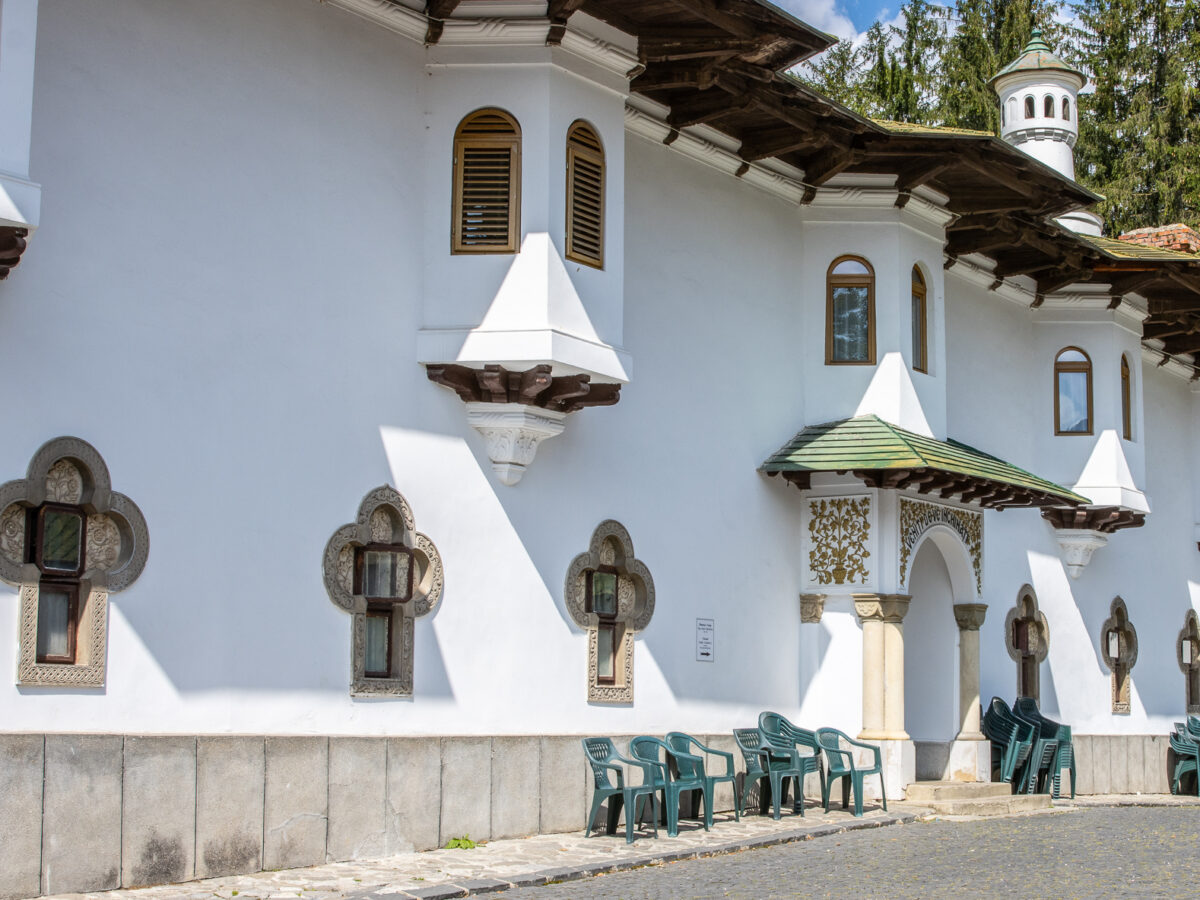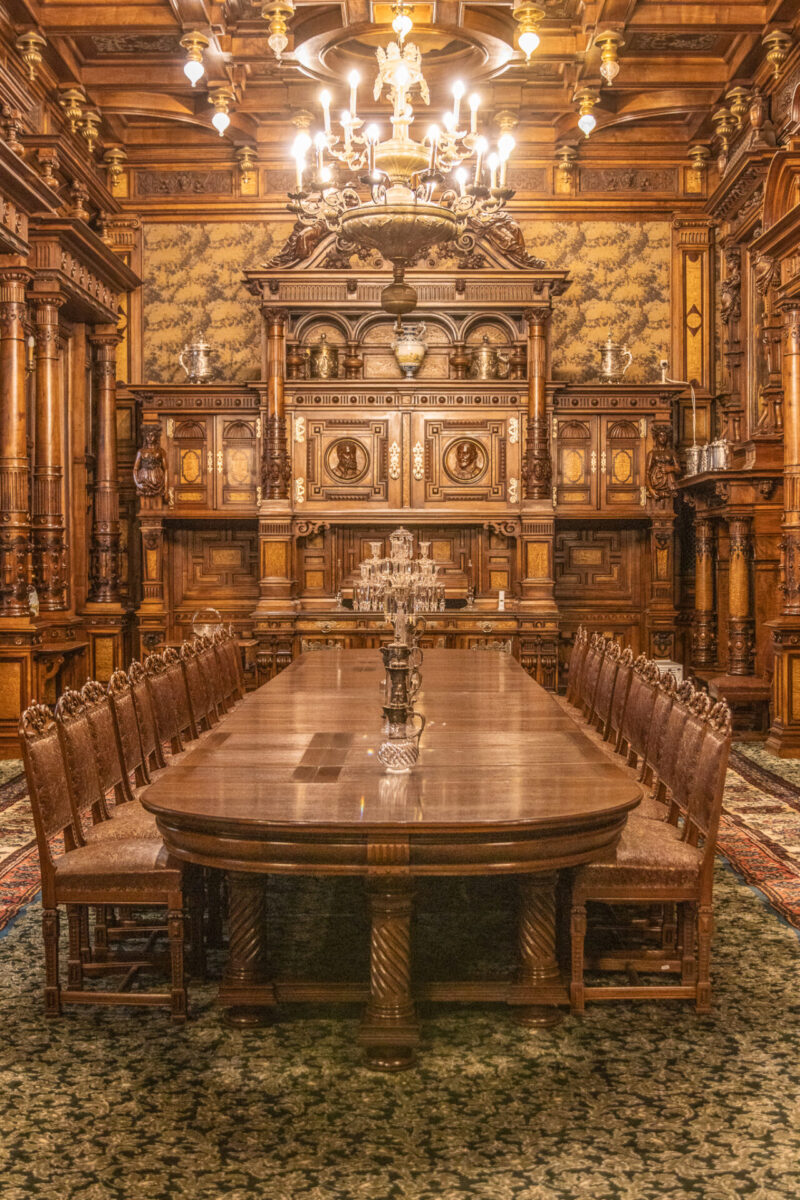For our first full day with our Gate 1 tour group, we drove back to the Carpathian mountains to visit Sinaia and Peles Castle, about 1/2 of the distance we had just traveled to Brasov. Now it was time for us to turn off our logistic brains and focus on learning and deeper history.
The previous night, we arrived in Bucharest and settled in to the InterContinental Athénée Palace Hotel, which we found to be quite comfortable. Upon checking, we were also upgraded to a room in the newer wing, given a complimentary amenity of drink coupons for the bar, and given a points bonus for being an IHG Premier Elite member (through my United Club card). We learned from the receptionist that the hotel was known for being a den of spies during the Cold War, which added a bit of fun history to the location.

We met up with our Gate 1 tour group at 6PM for a briefing followed by dinner, and met our tour manager Eronida (Nida for short) and our fellow 15 travelers. This was a small group Discovery Gate 1 tour which can fit up to 22 people, offering a more intimate format than the Classic tour we took of Morocco in 2017. We were lucky enough to only have 17 people though. We got some beer/wine and snacks and sat down to meet everyone. We were the youngest in the group with most people having a decade or two on us. One person, who we later learned was named Kathy, even commented that it would likely feel like we were traveling with our parents. We had hoped for at least one other couple our age, but after Antarctica the year before and some of our cruises, we were fully prepared for an older clientele.
The orientation was a pretty standard logistics briefing. We learned where everyone was from, which was primarily the USA, with one Canadian, and one couple from Australia (but originally from Canada). However, an interesting twist was that at least 4 of the couples, so almost half the tour was made up of Indians who now lived in the states. CJ was amongst her people again, so she knew she could hang.
After the orientation we had dinner in the hotel restaurant, which was just an okay chicken breast. We sat with Jay and Chandrika and got to know them a bit better. We also got to briefly meet our driver for the trip, Dragan, from Croatia. We tried the local beer, Bucur, which we enjoyed, especially the little top hat on the logo:

After we went to the bar, had some amazing Old Fashioneds and a chat at the bar with the bartender and a gentlemen who was shooting a commercial in Bucharest and handled the lighting. He had worked on many big films (Fast and the Furious series) and was lamenting the strike and all the damage across the world it was doing. We always find it interesting to meet other travelers and learn more about them and their perspectives.


The hotel room was really comfortable and fortunately the AC worked, and it offered a good breakfast the following morning.
Then we gathered on the coach and headed back up the way we had just came from Brasov. We met our local guide Cornell (short for Corenlius) and he started to tell us about the region and its history. We learned that all of the sunflowers we had seen on our previous trip up were for the production of sunflower oil for cooking since olives did not grow in this region.
After about an hour, we first stopped in Sinaia, a mountainous alpine village just a bit south of Brasov in Prahova Valley. The first stop of the tour was at the Sinaia Monastery which was on a beautiful mountainside with lush grounds and gardens. Monastery was founded by Prince Mihail Cantacuzinoo and named after Saint Catherine’s Monastery on Mount Sinai (hence the name). Two churches were on the grounds with the smaller of the two being especially interesting and intricate. The original church built in 1695 and new church was constructed in the mid 19th century.

































After the monastery we walked down to a local hotel for lunch, passing a cemetery and a more residential part of Sinaia along the way. We enjoy learning about death rituals across our travels – in Romania there is no coffin, and the deceased is simply bound in cloth and lowered into the ground. The thinking is that one should leave the world the same way one came in.




At the restaurant, we had our first and worst food experience with Gate 1 on the road. We’ll talk about this throughout the trip, but we rarely got choices of what to order, and if you marked you ate meat on the Gate 1 intake form, you always got meat with no option for vegetarian. This restaurant offered overcooked and bland Perch with a few carrots and potatoes. Everyone added copious amounts of salt and pepper and were lamenting not having some sauce to put on top. Although all of us got off better than what Jay got for a vegetarian meal. It was literally just a plate with two huge mounds of polenta on one side, and the biggest slop of sour cream on the other half. He joked/seriously mentioned how that was his quotient of sour cream that he would need for a whole year, not one meal. None of us could fathom why they didn’t just pluck the fish off a dish and provide the carrots and potatoes for the vegetarians. It would have been far easier and far more edible. On the other hand, the ice cream sundae for dessert was incredible and heaped with chocolate sauce.
After lunch we got back into the coach for the quick zip up to Peles Castle. The grounds of the castle were even more majestic than the monastery, and the castle had a very unique Germanic look.









It was built in the late 19th century by King Carol I, who we learned about previously on our tour of Bran Castle (he was the first Romanian king). The inside of Peles Castle was a wood explosion, with ornate details everywhere. Materials like only the finest wood, Venetian glass, huge mirrors without a single blemish filled the rooms.















In the armory we saw the sword that we had heard about the day before in Brasov that was used for executions of the nobility (offering a quick death as compared to hanging). The inscription on the sword offered the victim a quick path to heaven.

Overall, we felt that while Peles was beautiful, it was more representative of German architecture than Romanian. We were glad we had the opportunity to go to Bran castle as well to be able to compare and contrast. Our favorite rooms ended up being the Moroccan room as well as the music room.



The best part of Peles castle was the grounds, and we saw several foxes roaming around.




After the castle we headed back to Bucharest. We had some short time to freshen up for dinner and then headed to La Mama for dinner along a large, shared table, where the group immediately began sharing travel stories to break the ice. Dinner started with mezze dips, like eggplant, which were excellent, then we both had goulash, finishing off with a huge puff type pastry with a bread type texture, and cream and berries on top. It was called Papanasi and La Mama is supposed to be one of the best locations to try this delicacy. We found it a little too bready and a huge portion size.

After dinner we took a wander down to the Bucharest Old Town. We entered the area by taking Victory Avenue and winding through a hookah alley, which was unlike anything we had ever seen, and clearly was a callback to the Ottoman history. The Old Town was active with mostly restaurants, bars, and club goers, and while we enjoyed the vibe, we didn’t need to see it deeply twice. After a 15 minute stroll back to our hotel, we turned in for the night.

